Biomimetic Superhydrophobic Materials through 3D Printing: Progress and Challenges
Abstract
:1. Introduction
2. Natural Superhydrophobic Surfaces and Wetting Regimes
2.1. Natural Superhydrophobic Surfaces—“Lotus Leaf Effect” and “Rose Petal Effect”


2.2. Wetting Regimes
2.2.1. Wenzel Model
2.2.2. Cassie–Baxter Model
2.2.3. Intermediate Models
2.2.4. Debates
3. Three-Dimensionally Printed Superhydrophobic Materials
3.1. Three-Dimensional Printing Technologies
3.2. Three-Dimensional Printing of Biometric Superhydrophobic Materials
3.2.1. Three-Dimensional Printing of Special Micro/Nanostructures
3.2.2. Post-Modification of 3D Printed Objects
3.2.3. Three-Dimensional Printing of Bulk Materials
4. Applications of 3D Printed Superhydrophobic Materials
4.1. Liquid Manipulation
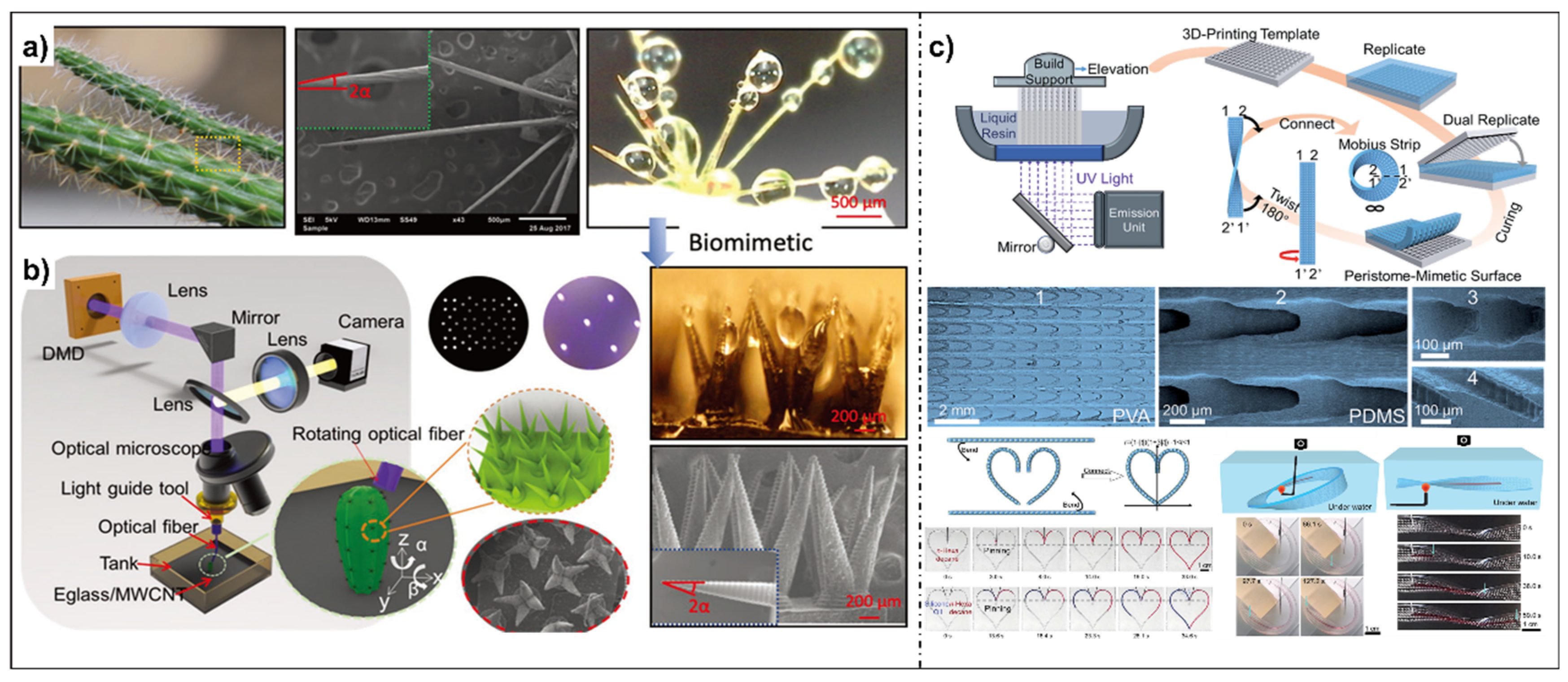
4.2. Oil/Water Separation
4.3. Drag Reduction
4.4. Potential Application in Anti-Icing
5. Conclusions and Outlook
5.1. Current Progress
5.2. Challenges and Perspectives
- (1)
- For one thing, the “structure–performance” relationship is absent in the current field. As a result, to solve this problem, computer-assisted design of structures with superhydrophobicity should be taken into consideration. Various computational methods, such as density function theory (DFT), molecular dynamics (MD), ab initio molecular dynamics (AIMD), and finite element analysis, should be used together for construction of “structure–performance” relationships. With the aid of these methods, machine learning, which can improve screening efficiency for suitable structures, should be applied in future 3D printing of superhydrophobic objects.
- (2)
- In addition, printing of bulk materials in one step may be one of the main research hot spots due to the inherent superhydrophobicity that is not limited to the surfaces. To realize facile fabrication of such structures, currently developed photopolymerization-induced microphase separation (PIMS) systems based on reversible addition–fragmentation chain transfer (RAFT) polymerization with tunable micro/nanoscale structures with improved mechanical stability show great potential in 3D printing of superhydrophobic objects. In PIMS, the chain of a macromolecular chain transfer agent (macro-CTA) is extended via RAFT polymerization, generating block copolymers with thermodynamically incompatible block segments. The PIMS method has advantages for the facile fabrication of objects with rapid speed, excellent robustness, and precise control of morphologies, which can be applied in future fabrication of superhydrophobic materials through photo-induced 3D printing strategies, i.e., DLP and SLA.
- (3)
- Moreover, in addition to traditional 3D printing, four-dimensional (4D) printing of “smart” materials has attracted attention since 2013. Dynamic structures with tunable shape, property, or functionality responding to stimuli can be printed by 4D printing. The external stimuli can be light, temperature, pH, etc. Shape-memory materials, which can be applied directly, multimaterial integration, and mathematical modeling-guided design of deformation energy based on stress mismatch between two layers are the three main strategies in 4D printing. The application of 4D printing in fabrication of superhydrophobic materials will definitely provide new ideas in generating smart devices with multifunctional structures to meet increasing demands in wider applications.
- (4)
- In addition, due to the capability of 3D printing in facile customizable design of meter-sized objects through, e.g., SLS/M, the printed superhydrophobic materials could be used in practical applications in industry and daily life in the near future.
- (5)
- Last, but most important, more bioinspired surfaces beyond superhydrophobicity can be built from 3D printing, leading to further understanding of natural phenomena and construction of “structure–performance” relationships depending on different surfaces, inspiring the design of brand-new devices for wider applications.
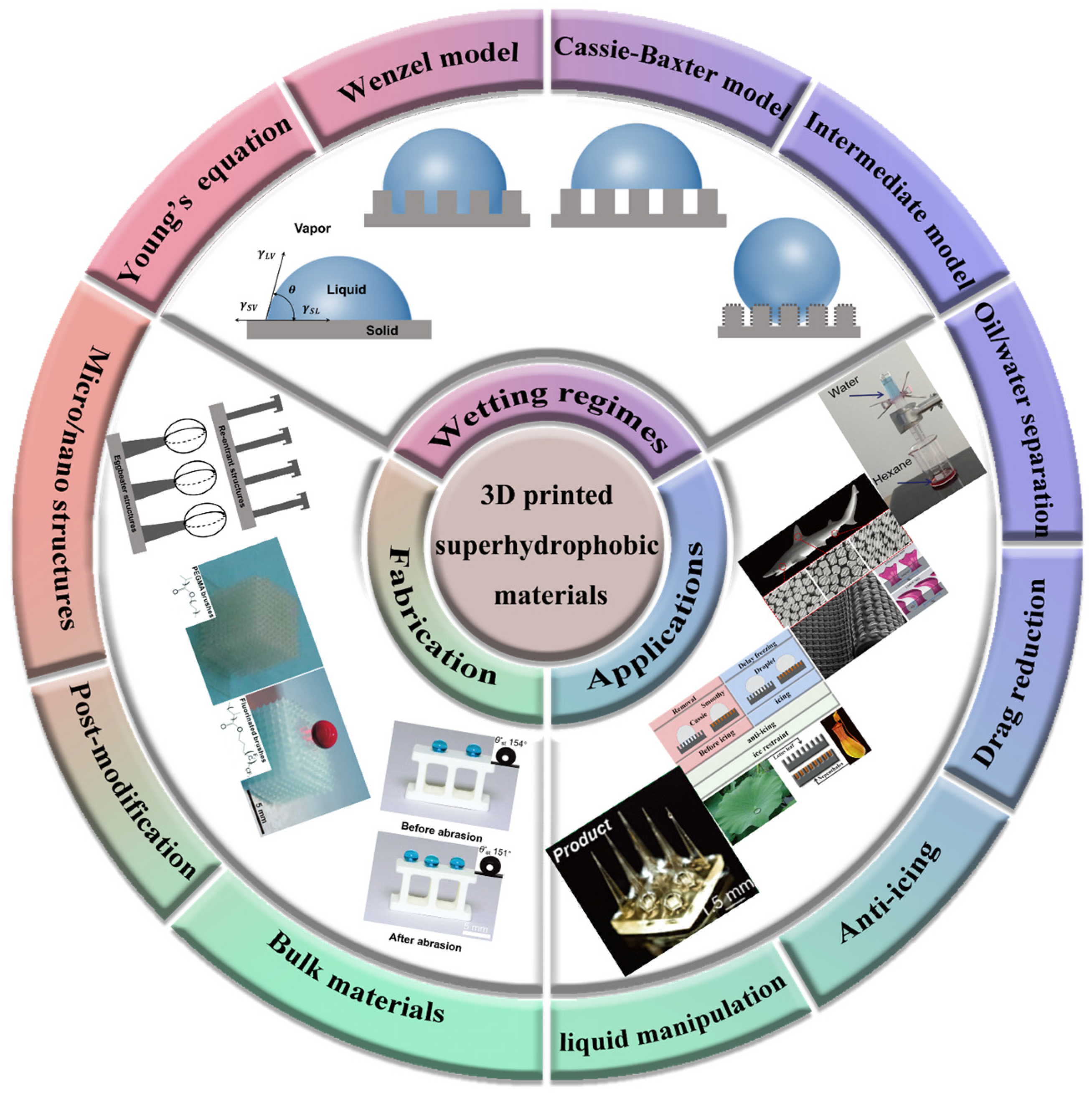
Author Contributions
Funding
Data Availability Statement
Acknowledgments
Conflicts of Interest
References
- Vogel, S. Life’s Devices: The Physical World of Animals and Plants; Princeton University Press: Princeton, NJ, USA, 1988. [Google Scholar]
- Liu, M.J.; Zheng, Y.M.; Zhai, J.; Jiang, L. Bioinspired Super-antiwetting Interfaces with Special Liquid-Solid Adhesion. Acc. Chem. Res. 2010, 43, 368–377. [Google Scholar] [CrossRef] [PubMed]
- Douglas, T. Materials science. A bright bio-inspired future. Science 2003, 299, 1192–1193. [Google Scholar] [CrossRef] [PubMed] [Green Version]
- Sanchez, C.; Arribart, H.; Guille, M.M. Biomimetism and bioinspiration as tools for the design of innovative materials and systems. Nat. Mater. 2005, 4, 277–288. [Google Scholar] [CrossRef] [PubMed]
- Parker, A.R.; Lawrence, C.R. Water capture by a desert beetle. Nature 2001, 414, 33–34. [Google Scholar] [CrossRef]
- Gu, Z.Z.; Uetsuka, H.; Takahashi, K.; Nakajima, R.; Onishi, H.; Fujishima, A.; Sato, O. Structural color and the lotus effect. Angew. Chem. Int. Ed. 2003, 42, 894–897. [Google Scholar] [CrossRef]
- Hancock, M.J.; Sekeroglu, K.; Demirel, M.C. Bioinspired Directional Surfaces for Adhesion, Wetting and Transport. Adv. Funct. Mater. 2012, 22, 2223–2234. [Google Scholar] [CrossRef] [Green Version]
- Lee, H.; Lee, B.P.; Messersmith, P.B. A reversible wet/dry adhesive inspired by mussels and geckos. Nature 2007, 448, 338–341. [Google Scholar] [CrossRef]
- Zan, G.; Wu, Q. Biomimetic and Bioinspired Synthesis of Nanomaterials/Nanostructures. Adv. Mater. 2016, 28, 2099–2147. [Google Scholar] [CrossRef]
- Feng, L.; Li, S.H.; Li, Y.S.; Li, H.J.; Zhang, L.J.; Zhai, J.; Song, Y.; Liu, B.; Jiang, L.; Zhu, D. Super-Hydrophobic Surfaces: From Natural to Artificial. Adv. Mater. 2002, 14, 1857–1860. [Google Scholar] [CrossRef]
- Karaman, M.; Cabuk, N.; Ozyurt, D.; Koysuren, O. Self-supporting superhydrophobic thin polymer sheets that mimic the nature’s petal effect. Appl. Surf. Sci. 2012, 259, 542–546. [Google Scholar] [CrossRef]
- Fratzl, P.; Barth, F.G. Biomaterial systems for mechanosensing and actuation. Nature 2009, 462, 442–448. [Google Scholar] [CrossRef] [PubMed]
- Wong, T.S.; Kang, S.H.; Tang, S.K.; Smythe, E.J.; Hatton, B.D.; Grinthal, A.; Aizenberg, J. Bioinspired self-repairing slippery surfaces with pressure-stable omniphobicity. Nature 2011, 477, 443–447. [Google Scholar] [CrossRef] [PubMed]
- Kong, T.; Luo, G.; Zhao, Y.; Liu, Z. Bioinspired Superwettability Micro/Nanoarchitectures: Fabrications and Applications. Adv. Funct. Mater. 2019, 29, 1808012. [Google Scholar] [CrossRef]
- Wenzel, R.W. Resistance of Solid Surfaces to Wetting by Water. Ind. Eng. Chem. 1936, 28, 988–994. [Google Scholar] [CrossRef]
- Cassie, A.B.; Baxter, S. Wettability of porous surfaces. Trans. Faraday Soc. 1944, 40, 546–550. [Google Scholar] [CrossRef]
- Luo, C.; Xiang, M.; Heng, X. A stable intermediate wetting state after a water drop contacts the bottom of a microchannel or is placed on a single corner. Langmuir 2012, 28, 9554–9561. [Google Scholar] [CrossRef]
- Nagayama, G.; Zhang, D. Intermediate wetting state at nano/microstructured surfaces. Soft Matter 2020, 16, 3514–3521. [Google Scholar] [CrossRef]
- Himma, N.F.; Prasetya, N.; Anisah, S.; Wenten, I.G. Superhydrophobic membrane: Progress in preparation and its separation properties. Rev. Chem. Eng. 2019, 35, 211–238. [Google Scholar] [CrossRef]
- Jing, X.; Guo, Z. Biomimetic super durable and stable surfaces with superhydrophobicity. J. Mater. Chem. A 2018, 6, 16731–16768. [Google Scholar] [CrossRef]
- Quan, Y.-Y.; Chen, Z.; Lai, Y.; Huang, Z.-S.; Li, H. Recent advances in fabricating durable superhydrophobic surfaces: A review in the aspects of structures and materials. Mater. Chem. Front. 2021, 5, 1655–1682. [Google Scholar] [CrossRef]
- Wen, G.; Guo, Z.; Liu, W. Biomimetic polymeric superhydrophobic surfaces and nanostructures: From fabrication to applications. Nanoscale 2017, 9, 3338–3366. [Google Scholar] [CrossRef] [PubMed]
- Fritzler, K.B.; Prinz, V.Y. 3D printing methods for micro- and nanostructures. Phys. -Usp. 2019, 62, 54–69. [Google Scholar] [CrossRef]
- Quan, H.; Zhang, T.; Xu, H.; Luo, S.; Nie, J.; Zhu, X. Photo-curing 3D printing technique and its challenges. Bioact. Mater. 2020, 5, 110–115. [Google Scholar] [CrossRef] [PubMed]
- Li, J.; Boyer, C.; Zhang, X. 3D Printing based on Photopolymerization and Photocatalysts: Review and Prospect. Macromol. Mater. Eng. 2022, 307, 2200010. [Google Scholar] [CrossRef]
- Park, Y.G.; Yun, I.; Chung, W.G.; Park, W.; Lee, D.H.; Park, J.U. High-Resolution 3D Printing for Electronics. Adv. Sci. 2022, 9, e2104623. [Google Scholar] [CrossRef] [PubMed]
- Divakaran, N.; Das, J.P.; Kumar, A.P.V.; Mohanty, S.; Ramadoss, A.; Nayak, S.K. Comprehensive review on various additive manufacturing techniques and its implementation in electronic devices. J. Manuf. Syst. 2022, 62, 477–502. [Google Scholar] [CrossRef]
- Kalkal, A.; Kumar, S.; Kumar, P.; Pradhan, R.; Willander, M.; Packirisamy, G.; Kumar, S.; Malhotra, B.D. Recent advances in 3D printing technologies for wearable (bio)sensors. Addit. Manuf. 2021, 46, 102088. [Google Scholar] [CrossRef]
- Hu, S.T.; Cao, X.B.; Reddyhoff, T.; Puhan, D.; Vladescu, S.C.; Wang, J.; Shi, X.; Peng, Z.K.; DeMello, A.J.; Dini, D. Liquid repellency enhancement through flexible microstructures. Sci. Adv. 2020, 6, eaba9721. [Google Scholar] [CrossRef]
- Liu, X.; Gu, H.; Ding, H.; Du, X.; He, Z.; Sun, L.; Liao, J.; Xiao, P.; Gu, Z. Programmable Liquid Adhesion on Bio-Inspired Re-Entrant Structures. Small 2019, 15, e1902360. [Google Scholar] [CrossRef]
- Liu, X.; Gu, H.; Wang, M.; Du, X.; Gao, B.; Elbaz, A.; Sun, L.; Liao, J.; Xiao, P.; Gu, Z. 3D Printing of Bioinspired Liquid Superrepellent Structures. Adv. Mater. 2018, 30, e1800103. [Google Scholar] [CrossRef]
- Tricinci, O.; Terencio, T.; Mazzolai, B.; Pugno, N.M.; Greco, F.; Mattoli, V. 3D Micropatterned Surface Inspired by Salvinia molesta via Direct Laser Lithography. ACS Appl. Mater. Interfaces 2015, 7, 25560–25567. [Google Scholar] [CrossRef] [PubMed] [Green Version]
- Yang, Y.; Li, X.; Zheng, X.; Chen, Z.; Zhou, Q.; Chen, Y. 3D-Printed Biomimetic Super-Hydrophobic Structure for Microdroplet Manipulation and Oil/Water Separation. Adv. Mater. 2018, 30, 1704912. [Google Scholar] [CrossRef] [PubMed]
- Barraza, B.; Olate-Moya, F.; Montecinos, G.; Ortega, J.H.; Rosenkranz, A.; Tamburrino, A.; Palza, H. Superhydrophobic SLA 3D printed materials modified with nanoparticles biomimicking the hierarchical structure of a rice leaf. Sci. Technol. Adv. Mater. 2022, 23, 300–321. [Google Scholar] [CrossRef] [PubMed]
- Kim, D.; Sasidharanpillai, A.; Lee, Y.; Lee, S. Self-Stratified Versatile Coatings for Three-Dimensional Printed Underwater Physical Sensors Applications. Nano Lett. 2021, 21, 6820–6827. [Google Scholar] [CrossRef] [PubMed]
- Wang, X.; Cai, X.; Guo, Q.; Zhang, T.; Kobe, B.; Yang, J. i3DP, a robust 3D printing approach enabling genetic post-printing surface modification. Chem. Commun. 2013, 49, 10064–10066. [Google Scholar] [CrossRef] [PubMed]
- Dong, Z.Q.; Vuckovac, M.; Cui, W.J.; Zhou, Q.; Ras, R.H.A.; Levkin, P.A. 3D Printing of Superhydrophobic Objects with Bulk Nanostructure. Adv. Mater. 2021, 33, 2106068. [Google Scholar] [CrossRef]
- Wu, Z.; Shi, C.; Chen, A.; Li, Y.; Chen, S.; Sun, D.; Wang, C.; Liu, Z.; Wang, Q.; Huang, J.; et al. Large-Scale, Abrasion-Resistant, and Solvent-Free Superhydrophobic Objects Fabricated by a Selective Laser Sintering 3D Printing Strategy. Adv. Sci. 2023, 10, e2207183. [Google Scholar] [CrossRef]
- Koch, K.; Bhushan, B.; Barthlott, W. Multifunctional surface structures of plants: An inspiration for biomimetics. Prog. Mater. Sci. 2009, 54, 137–178. [Google Scholar] [CrossRef]
- Koch, K.; Bhushan, B.; Jung, Y.C.; Barthlott, W. Fabrication of artificial Lotus leaves and significance of hierarchical structure for superhydrophobicity and low adhesion. Soft Matter 2009, 5, 1386–1393. [Google Scholar] [CrossRef]
- Barthlott, W.; Neinhuis, C. Purity of the sacred lotus, or escape from contamination in biological surfaces. Planta 1997, 202, 1–8. [Google Scholar] [CrossRef]
- Kumar, M.; Bhardwaj, R. Wetting characteristics of Colocasia esculenta (Taro) leaf and a bioinspired surface thereof. Sci. Rep. 2020, 10, 935. [Google Scholar] [CrossRef] [PubMed] [Green Version]
- Bing, W.; Wang, H.; Tian, L.M.; Zhao, J.; Jin, H.C.; Du, W.B.; Ren, L.Q. Small Structure, Large Effect: Functional Surfaces Inspired by Salvinia Leaves. Small Struct. 2021, 2, 2100079. [Google Scholar] [CrossRef]
- Ensikat, H.J.; Ditsche-Kuru, P.; Neinhuis, C.; Barthlott, W. Superhydrophobicity in perfection: The outstanding properties of the lotus leaf. Beilstein J. Nanotech. 2011, 2, 152–161. [Google Scholar] [CrossRef] [Green Version]
- Gao, A.; Zhao, Y.; Yang, Q.; Fu, Y.; Xue, L. Facile preparation of patterned petal-like PLA surfaces with tunable water micro-droplet adhesion properties based on stereo-complex co-crystallization from non-solvent induced phase separation processes. J. Mater. Chem. A 2016, 4, 12058–12064. [Google Scholar] [CrossRef]
- Yeh, K.Y.; Cho, K.H.; Yeh, Y.H.; Promraksa, A.; Huang, C.H.; Hsu, C.C.; Chen, L.J. Observation of the rose petal effect over single- and dual-scale roughness surfaces. Nanotechnology 2014, 25, 345303. [Google Scholar] [CrossRef] [PubMed]
- Feng, L.; Zhang, Y.; Xi, J.; Zhu, Y.; Wang, N.; Xia, F.; Jiang, L. Petal Effect: A Superhydrophobic State with High Adhesive Force. Langmuir 2008, 24, 4114–4119. [Google Scholar] [CrossRef] [PubMed]
- Jiaqiang, E.; Jin, Y.; Deng, Y.; Zuo, W.; Zhao, X.; Han, D.; Peng, Q.; Zhang, Z. Wetting Models and Working Mechanisms of Typical Surfaces Existing in Nature and Their Application on Superhydrophobic Surfaces: A Review. Adv. Mater. Interfaces 2017, 5, 1701052. [Google Scholar]
- Young, T. An Essay on the Cohesion of Fluids. Philos. Trans. R. Soc. Lond. 1805, 95, 65–87. [Google Scholar]
- Marmur, A. Wetting on Hydrophobic Rough Surfaces: To Be Heterogeneous or Not To Be? Langmuir 2003, 19, 8343–8348. [Google Scholar] [CrossRef]
- Miwa, M.; Nakajima, A.; Fujishima, A.; Hashimoto, K.; Watanabe, T. Effects of the Surface Roughness on Sliding Angles of Water Droplets on Superhydrophobic Surfaces. Langmuir 2000, 16, 5754–5760. [Google Scholar] [CrossRef]
- Liu, Y.; Choi, C.-H. Condensation-induced wetting state and contact angle hysteresis on superhydrophobic lotus leaves. Colloid Polym. Sci. 2012, 291, 437–445. [Google Scholar] [CrossRef]
- Luo, C.; Xiang, M. Existence and stability of an intermediate wetting state on circular micropillars. Microfluid. Nanofluid. 2014, 17, 539–548. [Google Scholar] [CrossRef]
- Yang, J.; Wang, J.; Wang, C.-W.; He, X.; Li, Y.; Chen, J.-B.; Zhou, F. Intermediate wetting states on nanoporous structures of anodic aluminum oxide surfaces. Thin Solid Films 2014, 562, 353–360. [Google Scholar] [CrossRef]
- Gao, L.; McCarthy, T.J. How Wenzel and cassie were wrong. Langmuir 2007, 23, 3762–3765. [Google Scholar] [CrossRef]
- Erbil, H.Y.; Cansoy, C.E. Range of applicability of the Wenzel and Cassie-Baxter equations for superhydrophobic surfaces. Langmuir 2009, 25, 14135–14145. [Google Scholar] [CrossRef]
- Vogler, E.A. Structure and reactivity of water at biomaterial surfaces. Adv. Colloid Interface Sci. 1998, 74, 69–117. [Google Scholar] [CrossRef]
- Li, Y.; He, S.; Xu, Z.; Luo, Z.; Xiao, H.; Tian, Y.; Jiang, L. Investigation on the intrinsic wetting thresholds of liquids by measuring the interaction forces of self-assembled monolayers. Nano Res. 2022, 15, 4344–4349. [Google Scholar] [CrossRef]
- Wang, L.; Zhao, Y.; Tian, Y.; Jiang, L. A General Strategy for the Separation of Immiscible Organic Liquids by Manipulating the Surface Tensions of Nanofibrous Membranes. Angew. Chem. Int. Ed. 2015, 54, 14732–14737. [Google Scholar] [CrossRef]
- Lee, J.; Kim, H.-C.; Choi, J.-W.; Lee, I.H. A review on 3D printed smart devices for 4D printing. Int. J. Precis. Eng. Manuf.-Green Technol. 2017, 4, 373–383. [Google Scholar] [CrossRef]
- Melchels, F.P.; Feijen, J.; Grijpma, D.W. A review on stereolithography and its applications in biomedical engineering. Biomaterials 2010, 31, 6121–6130. [Google Scholar] [CrossRef] [Green Version]
- Zhang, J.; Hu, Q.; Wang, S.; Tao, J.; Gou, M. Digital Light Processing Based Three-dimensional Printing for Medical Applications. Int. J. Bioprint. 2020, 6, 242. [Google Scholar] [CrossRef] [PubMed]
- Tumbleston, J.R.; Shirvanyants, D.; Ermoshkin, N.; Janusziewicz, R.; Johnson, A.R.; Kelly, D.; Chen, K.; Pinschmidt, R.; Rolland, J.P.; Ermoshkin, A.; et al. Continuous liquid interface production of 3D objects. qScience 2015, 347, 1349–1352. [Google Scholar] [CrossRef] [PubMed]
- Carlotti, M.; Mattoli, V. Functional Materials for Two-Photon Polymerization in Microfabrication. Small 2019, 15, e1902687. [Google Scholar] [CrossRef] [PubMed]
- Zub, K.; Hoeppener, S.; Schubert, U.S. Inkjet Printing and 3D Printing Strategies for Biosensing, Analytical, and Diagnostic Applications. Adv. Mater. 2022, 34, e2105015. [Google Scholar] [CrossRef] [PubMed]
- Saadi, M.; Maguire, A.; Pottackal, N.T.; Thakur, M.S.H.; Ikram, M.M.; Hart, A.J.; Ajayan, P.M.; Rahman, M.M. Direct Ink Writing: A 3D Printing Technology for Diverse Materials. Adv. Mater. 2022, 34, e2108855. [Google Scholar] [CrossRef]
- Penumakala, P.K.; Santo, J.; Thomas, A. A critical review on the fused deposition modeling of thermoplastic polymer composites. Compos. Part B 2020, 201, 108336. [Google Scholar] [CrossRef]
- Shirazi, S.F.; Gharehkhani, S.; Mehrali, M.; Yarmand, H.; Metselaar, H.S.; Adib Kadri, N.; Osman, N.A. A review on powder-based additive manufacturing for tissue engineering: Selective laser sintering and inkjet 3D printing. Sci. Technol. Adv. Mater. 2015, 16, 033502. [Google Scholar] [CrossRef]
- Awad, A.; Fina, F.; Goyanes, A.; Gaisford, S.; Basit, A.W. Advances in powder bed fusion 3D printing in drug delivery and healthcare. Adv. Drug. Deliv. Rev. 2021, 174, 406–424. [Google Scholar] [CrossRef]
- Li, J.; Pumera, M. 3D printing of functional microrobots. Chem. Soc. Rev. 2021, 50, 2794–2838. [Google Scholar] [CrossRef]
- Shams, H.; Basit, K.; Khan, M.A.; Saleem, S.; Mansoor, A. Realizing surface amphiphobicity using 3D printing techniques: A critical move towards manufacturing low-cost reentrant geometries. Addit. Manuf. 2021, 38, 101777. [Google Scholar] [CrossRef]
- Huang, J.; Qin, Q.; Wang, J. A Review of Stereolithography: Processes and Systems. Processes 2020, 8, 1138. [Google Scholar] [CrossRef]
- Skoog, S.A.; Goering, P.L.; Narayan, R.J. Stereolithography in tissue engineering. J. Mater. Sci. Mater. Med. 2014, 25, 845–856. [Google Scholar] [CrossRef] [PubMed]
- Sutton, J.T.; Rajan, K.; Harper, D.P.; Chmely, S.C. Lignin-Containing Photoactive Resins for 3D Printing by Stereolithography. ACS Appl. Mater. Interfaces 2018, 10, 36456–36463. [Google Scholar] [CrossRef] [PubMed]
- Zakeri, S.; Vippola, M.; Levänen, E. A comprehensive review of the photopolymerization of ceramic resins used in stereolithography. Addit. Manuf. 2020, 35, 101177. [Google Scholar] [CrossRef]
- Kim, S.H.; Yeon, Y.K.; Lee, J.M.; Chao, J.R.; Lee, Y.J.; Seo, Y.B.; Sultan, M.T.; Lee, O.J.; Lee, J.S.; Yoon, S.I.; et al. Precisely printable and biocompatible silk fibroin bioink for digital light processing 3D printing. Nat. Commun. 2018, 9, 1620. [Google Scholar] [CrossRef] [Green Version]
- Patel, D.K.; Sakhaei, A.H.; Layani, M.; Zhang, B.; Ge, Q.; Magdassi, S. Highly Stretchable and UV Curable Elastomers for Digital Light Processing Based 3D Printing. Adv. Mater. 2017, 29, 1606000. [Google Scholar] [CrossRef]
- Huang, B.; Hu, R.; Xue, Z.; Zhao, J.; Li, Q.; Xia, T.; Zhang, W.; Lu, C. Continuous liquid interface production of alginate/polyacrylamide hydrogels with supramolecular shape memory properties. Carbohydr. Polym. 2020, 231, 115736. [Google Scholar] [CrossRef]
- Johnson, A.R.; Caudill, C.L.; Tumbleston, J.R.; Bloomquist, C.J.; Moga, K.A.; Ermoshkin, A.; Shirvanyants, D.; Mecham, S.J.; Luft, J.C.; DeSimone, J.M. Single-Step Fabrication of Computationally Designed Microneedles by Continuous Liquid Interface Production. PLoS ONE 2016, 11, e0162518. [Google Scholar] [CrossRef] [Green Version]
- McGregor, D.J.; Tawfick, S.; King, W.P. Mechanical properties of hexagonal lattice structures fabricated using continuous liquid interface production additive manufacturing. Addit. Manuf. 2019, 25, 10–18. [Google Scholar] [CrossRef] [Green Version]
- Jiang, L.J.; Campbell, J.H.; Lu, Y.F.; Bernat, T.; Petta, N. Direct Writing Target Structures by Two-Photon Polymerization. Fusion Sci. Technol. 2017, 70, 295–309. [Google Scholar] [CrossRef]
- Oakdale, J.S.; Ye, J.; Smith, W.L.; Biener, J. Post-print UV curing method for improving the mechanical properties of prototypes derived from two-photon lithography. Opt. Express 2016, 24, 27077–27086. [Google Scholar] [CrossRef] [PubMed]
- Pearre, B.W.; Michas, C.; Tsang, J.M.; Gardner, T.J.; Otchy, T.M. Fast micron-scale 3D printing with a resonant-scanning two-photon microscope. Addit. Manuf. 2019, 30, 100887. [Google Scholar] [CrossRef] [PubMed]
- Tromayer, M.; Gruber, P.; Rosspeintner, A.; Ajami, A.; Husinsky, W.; Plasser, F.; Gonzalez, L.; Vauthey, E.; Ovsianikov, A.; Liska, R. Wavelength-optimized Two-Photon Polymerization Using Initiators Based on Multipolar Aminostyryl-1,3,5-triazines. Sci. Rep. 2018, 8, 17273. [Google Scholar] [CrossRef] [PubMed]
- An, B.W.; Kim, K.; Lee, H.; Kim, S.Y.; Shim, Y.; Lee, D.Y.; Song, J.Y.; Park, J.U. High-Resolution Printing of 3D Structures Using an Electrohydrodynamic Inkjet with Multiple Functional Inks. Adv. Mater. 2015, 27, 4322–4328. [Google Scholar] [CrossRef] [PubMed]
- Guo, Y.; Patanwala, H.S.; Bognet, B.; Ma, A.W.K. Inkjet and inkjet-based 3D printing: Connecting fluid properties and printing performance. Rapid. Prototyp. J. 2017, 23, 562–576. [Google Scholar] [CrossRef] [Green Version]
- Negro, A.; Cherbuin, T.; Lutolf, M.P. 3D Inkjet Printing of Complex, Cell-Laden Hydrogel Structures. Sci. Rep. 2018, 8, 17099. [Google Scholar] [CrossRef] [Green Version]
- Scoutaris, N.; Ross, S.; Douroumis, D. Current Trends on Medical and Pharmaceutical Applications of Inkjet Printing Technology. Pharm. Res. 2016, 33, 1799–1816. [Google Scholar] [CrossRef]
- Prashantha, K.; Roger, F. Multifunctional properties of 3D printed poly(lactic acid)/graphene nanocomposites by fused deposition modeling. J. Macromol. Sci. Part A Pure Appl.Chem. 2016, 54, 24–29. [Google Scholar] [CrossRef]
- Wasti, S.; Adhikari, S. Use of Biomaterials for 3D Printing by Fused Deposition Modeling Technique: A Review. Front. Chem. 2020, 8, 315. [Google Scholar] [CrossRef]
- Webbe Kerekes, T.; Lim, H.; Joe, W.Y.; Yun, G.J. Characterization of process–deformation/damage property relationship of fused deposition modeling (FDM) 3D-printed specimens. Addit. Manuf. 2019, 25, 532–544. [Google Scholar] [CrossRef]
- Weng, Z.; Wang, J.; Senthil, T.; Wu, L. Mechanical and thermal properties of ABS/montmorillonite nanocomposites for fused deposition modeling 3D printing. Mater. Des. 2016, 102, 276–283. [Google Scholar] [CrossRef]
- Awad, A.; Fina, F.; Goyanes, A.; Gaisford, S.; Basit, A.W. 3D printing: Principles and pharmaceutical applications of selective laser sintering. Int. J. Pharm. 2020, 586, 119594. [Google Scholar] [CrossRef] [PubMed]
- Espera, A.H.; Valino, A.D.; Palaganas, J.O.; Souza, L.; Chen, Q.; Advincula, R.C. 3D Printing of a Robust Polyamide-12-Carbon Black Composite via Selective Laser Sintering: Thermal and Electrical Conductivity. Macromol. Mater. Eng. 2019, 304, 1800718. [Google Scholar] [CrossRef]
- Pereira, T.F.; Oliveira, M.F.; Maia, I.A.; Silva, J.V.L.; Costa, M.F.; Thiré, R.M.S.M. 3D Printing of Poly(3-hydroxybutyrate) Porous Structures Using Selective Laser Sintering. Macromol. Symp. 2012, 319, 64–73. [Google Scholar] [CrossRef]
- Ouyang, D.; Li, N.; Xing, W.; Zhang, J.; Liu, L. 3D printing of crack-free high strength Zr-based bulk metallic glass composite by selective laser melting. Intermetallics 2017, 90, 128–134. [Google Scholar] [CrossRef]
- Ouyang, D.; Xing, W.; Li, N.; Li, Y.; Liu, L. Structural evolutions in 3D-printed Fe-based metallic glass fabricated by selective laser melting. Addit. Manuf. 2018, 23, 246–252. [Google Scholar] [CrossRef]
- Wei, C.; Li, L.; Zhang, X.; Chueh, Y.-H. 3D printing of multiple metallic materials via modified selective laser melting. CIRP Ann. 2018, 67, 245–248. [Google Scholar] [CrossRef] [Green Version]
- Xing, L.; Yu, J.; Ji, Z.; Huang, X.; Dai, C.; Zhang, Q. Study on Preparation of Superhydrophobic Surface by Selective Laser Melting and Corrosion Resistance. Appl. Sci. 2021, 11, 7476. [Google Scholar] [CrossRef]
- Kaur, G.; Marmur, A.; Magdassi, S. Fabrication of superhydrophobic 3D objects by Digital Light Processing. Addit. Manuf. 2020, 36, 101669. [Google Scholar] [CrossRef]
- Credi, C.; Levi, M.; Turri, S.; Simeone, G. Stereolithography of perfluoropolyethers for the microfabrication of robust omniphobic surfaces. Appl. Surf. Sci. 2017, 404, 268–275. [Google Scholar] [CrossRef]
- Helbig, R.; Nickerl, J.; Neinhuis, C.; Werner, C. Smart skin patterns protect springtails. PLoS ONE 2011, 6, e25105. [Google Scholar] [CrossRef] [PubMed] [Green Version]
- Hensel, R.; Helbig, R.; Aland, S.; Braun, H.G.; Voigt, A.; Neinhuis, C.; Werner, C. Wetting resistance at its topographical limit: The benefit of mushroom and serif T structures. Langmuir 2013, 29, 1100–1112. [Google Scholar] [CrossRef] [PubMed]
- Hensel, R.; Helbig, R.; Aland, S.; Voigt, A.; Neinhuis, C.; Werner, C. Tunable nano-replication to explore the omniphobic characteristics of springtail skin. NPG Asia Mater. 2013, 5, e37. [Google Scholar] [CrossRef] [Green Version]
- Cao, L.L.; Hu, H.H.; Gao, D. Design and fabrication of micro-textures for inducing a superhydrophobic behavior on hydrophilic materials. Langmuir 2007, 23, 4310–4314. [Google Scholar] [CrossRef]
- Liimatainen, V.; Drotlef, D.M.; Son, D.; Sitti, M. Liquid-Superrepellent Bioinspired Fibrillar Adhesives. Adv. Mater. 2020, 32, 2000497. [Google Scholar] [CrossRef]
- Lin, Y.; Zhou, R.; Xu, J. Superhydrophobic Surfaces Based on Fractal and Hierarchical Microstructures Using Two-Photon Polymerization: Toward Flexible Superhydrophobic Films. Adv. Mater. Interfaces 2018, 5, 1801126. [Google Scholar] [CrossRef]
- Yin, Q.; Guo, Q.; Wang, Z.L.; Chen, Y.Q.; Duan, H.G.; Cheng, P. 3D-Printed Bioinspired Cassie-Baxter Wettability for Controllable Microdroplet Manipulation. ACS Appl. Mater. Interfaces 2021, 13, 1979–1987. [Google Scholar] [CrossRef]
- Das, R.; Ahmad, Z.; Nauruzbayeva, J.; Mishra, H. Biomimetic Coating-free Superomniphobicity. Sci. Rep. 2020, 10, 7934. [Google Scholar] [CrossRef]
- Barthlott, W.; Schimmel, T.; Wiersch, S.; Koch, K.; Brede, M.; Barczewski, M.; Walheim, S.; Weis, A.; Kaltenmaier, A.; Leder, A.; et al. The salvinia paradox: Superhydrophobic surfaces with hydrophilic pins for air retention under water. Adv. Mater. 2010, 22, 2325–2328. [Google Scholar] [CrossRef]
- Koch, K.; Bohn, H.F.; Barthlott, W. Hierarchically sculptured plant surfaces and superhydrophobicity. Langmuir 2009, 25, 14116–14120. [Google Scholar] [CrossRef]
- Solga, A.; Cerman, Z.; Striffler, B.F.; Spaeth, M.; Barthlott, W. The dream of staying clean: Lotus and biomimetic surfaces. Bioinspir. Biomim. 2007, 2, S126–S134. [Google Scholar] [CrossRef] [PubMed]
- He, Z.K.; Chen, Y.Q.; Yang, J.; Tang, C.Y.; Lv, J.; Liu, Y.; Mei, J.; Lau, W.M.; Hui, D. Fabrication of Polydimethylsiloxane films with special surface wettability by 3D printing. Compos. Part B 2017, 129, 58–65. [Google Scholar] [CrossRef]
- Kang, B.; Hyeon, J.; So, H. Facile microfabrication of 3-dimensional (3D) hydrophobic polymer surfaces using 3D printing technology. Appl. Surf. Sci. 2020, 499, 143733. [Google Scholar] [CrossRef]
- Kang, B.; Sung, J.; So, H. Realization of Superhydrophobic Surfaces Based on Three-Dimensional Printing Technology. Int. J. Precis. Eng. Manuf.-Green Technol. 2019, 8, 47–55. [Google Scholar] [CrossRef]
- Lee, K.M.; Park, H.; Kim, J.; Chun, D.M. Fabrication of a superhydrophobic surface using a fused deposition modeling (FDM) 3D printer with poly lactic acid (PLA) filament and dip coating with silica nanoparticles. Appl. Surf. Sci. 2019, 467, 979–991. [Google Scholar] [CrossRef]
- Li, Y.; Mao, H.; Hu, P.; Hermes, M.; Lim, H.; Yoon, J.; Luhar, M.; Chen, Y.; Wu, W. Bioinspired Functional Surfaces Enabled by Multiscale Stereolithography. Adv. Mater. Technol. 2019, 4, 1800638. [Google Scholar] [CrossRef]
- Barahman, M.; Lyons, A.M. Ratchetlike slip angle anisotropy on printed superhydrophobic surfaces. Langmuir 2011, 27, 9902–9909. [Google Scholar] [CrossRef]
- Lv, J.; Gong, Z.; He, Z.; Yang, J.; Chen, Y.; Tang, C.; Liu, Y.; Fan, M.; Lau, W.-M. 3D printing of a mechanically durable superhydrophobic porous membrane for oil–water separation. J. Mater. Chem. A 2017, 5, 12435–12444. [Google Scholar] [CrossRef]
- Campos, J.Q.; Szczepanski, C.R.; Medici, M.G.; Godeau, G. Inspired by the Nature: A Post-printed Strategy to Efficiently Elaborate Parahydrophobic Surfaces. Biomimetics 2022, 7, 122. [Google Scholar] [CrossRef]
- Ciffreo, L.; Marchand, C.; Szczepanski, C.R.; Medici, M.G.; Godeau, G. Bioinspired and Post-Functionalized 3D-Printed Surfaces with Parahydrophobic Properties. Biomimetics 2021, 6, 71. [Google Scholar] [CrossRef]
- Gaxiola-Lopez, J.C.; Lara-Ceniceros, T.E.; Silva-Vidaurri, L.G.; Advincula, R.C.; Bonilla-Cruz, J. 3D Printed Parahydrophobic Surfaces as Multireaction Platforms. Langmuir 2022, 38, 7740–7749. [Google Scholar] [CrossRef] [PubMed]
- Guo, Y.; Luo, B.; Wang, X.; Liu, S.; Geng, T. Wettability control and oil/water separation performance of 3D-printed porous materials. J. Appl. Polym. Sci. 2021, 139, e51570. [Google Scholar] [CrossRef]
- Li, N.; Li, C.; Yu, C.; Wang, T.; Gao, C.; Dong, Z.; Jiang, L. Asymmetric micro-ratchets regulated drop dispensing on bamboo mimetic surface. J. Mater. Chem. A 2019, 7, 9550–9555. [Google Scholar] [CrossRef]
- Yuan, S.S.; Zhu, J.Y.; Li, Y.; Zhao, Y.; Li, J.; Van Puyvelde, P.; Van der Bruggen, B. Structure architecture of micro/nanoscale ZIF-L on a 3D printed membrane for a superhydrophobic and underwater superoleophobic surface. J. Mater. Chem. A 2019, 7, 2723–2729. [Google Scholar] [CrossRef]
- Zhang, Y.; Yin, M.-J.; Ouyang, X.; Zhang, A.P.; Tam, H.-Y. 3D μ-printing of polytetrafluoroethylene microstructures: A route to superhydrophobic surfaces and devices. Appl. Mater. Today 2020, 19, 100580. [Google Scholar] [CrossRef]
- Mayoussi, F.; Doeven, E.H.; Kick, A.; Goralczyk, A.; Thomann, Y.; Risch, P.; Guijt, R.M.; Kotz, F.; Helmer, D.; Rapp, B.E. Facile fabrication of micro-/nanostructured, superhydrophobic membranes with adjustable porosity by 3D printing. J. Mater. Chem. A 2021, 9, 21379–21386. [Google Scholar] [CrossRef] [PubMed]
- Kim, J.J.; Lee, J.; Yang, S.P.; Kim, H.G.; Kweon, H.S.; Yoo, S.; Jeong, K.H. Biologically Inspired Organic Light-Emitting Diodes. Nano Lett. 2016, 16, 2994–3000. [Google Scholar] [CrossRef]
- Leem, Y.C.; Park, J.S.; Kim, J.H.; Myoung, N.; Yim, S.Y.; Jeong, S.; Lim, W.; Kim, S.T.; Park, S.J. Light-Emitting Diodes with Hierarchical and Multifunctional Surface Structures for High Light Extraction and an Antifouling Effect. Small 2016, 12, 161–168. [Google Scholar] [CrossRef]
- Zhang, Y.-L.; Xia, H.; Kim, E.; Sun, H.-B. Recent developments in superhydrophobic surfaces with unique structural and functional properties. Soft Matter 2012, 8, 11217. [Google Scholar] [CrossRef]
- Li, Y.; Li, Z.; Wang, Q.; Wu, Z.; Shi, C.; Zhang, S.; Xu, Y.; Chen, X.; Chen, A.; Yan, C.; et al. 3D-printed magnetic porous structures with different poisson’s ratios and their mechanoelectrical conversion capabilities. Addit. Manuf. 2023, 69, 103542. [Google Scholar] [CrossRef]
- Ma, Z.; Wang, Q.; Wu, Z.; Chen, D.; Yan, C.; Shi, Y.; Dickey, M.D.; Su, B. A Superconducting-Material-Based Maglev Generator Used for Outer-Space. Adv. Mater. 2022, 34, e2203814. [Google Scholar] [CrossRef] [PubMed]
- Zhang, S.; Xia, Z.; Liu, Z.; Wang, Q.; Yue, Y.; Huang, J.; Su, B. Magnetic/conductive/elastic multi-material 3D-printed self-powered sensing gloves for underwater/smoke environmental Human-Computer Interaction. Chem. Eng. J. 2023, 463, 142388. [Google Scholar] [CrossRef]
- Li, C.; Zhang, Y.; Ju, J.; Cheng, F.; Liu, M.; Jiang, L.; Yu, Y. In Situ Fully Light-Driven Switching of Superhydrophobic Adhesion. Adv. Funct. Mater. 2012, 22, 760–763. [Google Scholar] [CrossRef]
- Lv, J.A.; Liu, Y.; Wei, J.; Chen, E.; Qin, L.; Yu, Y. Photocontrol of fluid slugs in liquid crystal polymer microactuators. Nature 2016, 537, 179–184. [Google Scholar] [CrossRef] [PubMed]
- Neto, A.I.; Levkin, P.A.; Mano, J.F. Patterned superhydrophobic surfaces to process and characterize biomaterials and 3D cell culture. Mater. Horiz. 2018, 5, 379–393. [Google Scholar] [CrossRef]
- Seo, J.; Lee, J.S.; Lee, K.; Kim, D.; Yang, K.; Shin, S.; Mahata, C.; Jung, H.B.; Lee, W.; Cho, S.W.; et al. Switchable water-adhesive, superhydrophobic palladium-layered silicon nanowires potentiate the angiogenic efficacy of human stem cell spheroids. Adv. Mater. 2014, 26, 7043–7050. [Google Scholar] [CrossRef]
- Shi, C.; Wu, Z.; Li, Y.; Zhang, X.; Xu, Y.; Chen, A.; Yan, C.; Shi, Y.; Wang, T.; Su, B. Superhydrophobic/Superhydrophilic Janus Evaporator for Extreme High Salt-Resistance Solar Desalination by an Integrated 3D Printing Method. ACS Appl. Mater. Interfaces 2023, 15, 23971–23979. [Google Scholar] [CrossRef]
- Liu, L.; Liu, S.; Schelp, M.; Chen, X. Rapid 3D Printing of Bioinspired Hybrid Structures for High-Efficiency Fog Collection and Water Transportation. ACS Appl. Mater. Interfaces 2021, 13, 29122–29129. [Google Scholar] [CrossRef]
- Liu, Y.; Zhang, H.; Wang, P.; He, Z.; Dong, G. 3D-printed bionic superhydrophobic surface with petal-like microstructures for droplet manipulation, oil-water separation, and drag reduction. Mater. Des. 2022, 219, 110765. [Google Scholar] [CrossRef]
- Peng, L.; Chen, K.; Chen, D.; Chen, J.; Tang, J.; Xiang, S.; Chen, W.; Liu, P.; Zheng, F.; Shi, J. Study on the enhancing water collection efficiency of cactus- and beetle-like biomimetic structure using UV-induced controllable diffusion method and 3D printing technology. RSC Adv. 2021, 11, 14769–14776. [Google Scholar] [CrossRef]
- Yu, C.; Li, C.; Gao, C.; Dong, Z.; Wu, L.; Jiang, L. Time-Dependent Liquid Transport on a Biomimetic Topological Surface. ACS Nano 2018, 12, 5149–5157. [Google Scholar] [CrossRef] [PubMed]
- Yuan, S.S.; Strobbe, D.; Kruth, J.P.; Van Puyvelde, P.; Van der Bruggen, B. Super-hydrophobic 3D printed polysulfone membranes with a switchable wettability by self-assembled candle soot for efficient gravity-driven oil/water separation. J. Mater. Chem. A 2017, 5, 25401–25409. [Google Scholar] [CrossRef]
- Lv, J.; Song, Y.; Jiang, L.; Wang, J. Bio-inspired strategies for anti-icing. ACS Nano 2014, 8, 3152–3169. [Google Scholar] [CrossRef] [PubMed]
- Ju, J.; Bai, H.; Zheng, Y.; Zhao, T.; Fang, R.; Jiang, L. A multi-structural and multi-functional integrated fog collection system in cactus. Nat. Commun. 2012, 3, 1247. [Google Scholar] [CrossRef] [PubMed] [Green Version]
- Ju, J.; Zheng, Y.; Jiang, L. Bioinspired one-dimensional materials for directional liquid transport. Acc. Chem. Res. 2014, 47, 2342–2352. [Google Scholar] [CrossRef] [PubMed]
- Li, X.; Yang, Y.; Liu, L.; Chen, Y.; Chu, M.; Sun, H.; Shan, W.; Chen, Y. 3D-Printed Cactus-Inspired Spine Structures for Highly Efficient Water Collection. Adv. Mater. Interfaces 2019, 7, 1901752. [Google Scholar] [CrossRef]
- Bauer, U.; Federle, W. The insect-trapping rim of Nepenthes pitchers: Surface structure and function. Plant Signal. Behav. 2009, 4, 1019–1023. [Google Scholar] [CrossRef] [Green Version]
- Bohn, H.F.; Federle, W. Insect aquaplaning: Nepenthes pitcher plants capture prey with the peristome, a fully wettable water-lubricated anisotropic surface. Proc. Natl. Acad. Sci. USA 2004, 101, 14138–14143. [Google Scholar] [CrossRef] [Green Version]
- Chen, H.; Zhang, P.; Zhang, L.; Liu, H.; Jiang, Y.; Zhang, D.; Han, Z.; Jiang, L. Continuous directional water transport on the peristome surface of Nepenthes alata. Nature 2016, 532, 85–89. [Google Scholar] [CrossRef]
- Zhou, S.; Yu, C.; Li, C.; Dong, Z.; Jiang, L. Programmable unidirectional liquid transport on peristome-mimetic surfaces under liquid environments. J. Mater. Chem. A 2019, 7, 18244–18248. [Google Scholar] [CrossRef]
- Jin, Z.; Mei, H.; Yan, Y.; Pan, L.; Liu, H.; Xiao, S.; Cheng, L. 3D-printed controllable gradient pore superwetting structures for high temperature efficient oil-water separation. J. Mater. 2021, 7, 8–18. [Google Scholar] [CrossRef]
- Li, G.; Mo, X.; Wang, Y.; Chan, C.Y.; Chan, K.C. All 3D-Printed Superhydrophobic/Oleophilic Membrane for Robotic Oil Recycling. Adv. Mater. Interfaces 2019, 6, 1900874. [Google Scholar] [CrossRef]
- Wen, L.; Weaver, J.C.; Lauder, G.V. Biomimetic shark skin: Design, fabrication and hydrodynamic function. J. Exp. Biol. 2014, 217, 1656–1666. [Google Scholar] [CrossRef] [PubMed] [Green Version]
- Du, P.; Wen, J.; Zhang, Z.; Song, D.; Ouahsine, A.; Hu, H. Maintenance of air layer and drag reduction on superhydrophobic surface. Ocean Eng. 2017, 130, 328–335. [Google Scholar] [CrossRef]
- McHale, G.; Flynn, M.R.; Newton, M.I. Plastron induced drag reduction and increased slip on a superhydrophobic sphere. Soft Matter 2011, 7, 10100. [Google Scholar] [CrossRef]
- Ren, W.; Trinh, P.H.; Weinan, E. On the distinguished limits of the Navier slip model of the moving contact line problem. J. Fluid Mech. 2015, 772, 107–126. [Google Scholar] [CrossRef] [Green Version]
- Li, B.; Bai, J.; He, J.; Ding, C.; Dai, X.; Ci, W.; Zhu, T.; Liao, R.; Yuan, Y. A Review on Superhydrophobic Surface with Anti-Icing Properties in Overhead Transmission Lines. Coatings 2023, 13, 301. [Google Scholar] [CrossRef]
- Wu, X.; Silberschmidt, V.V.; Hu, Z.-T.; Chen, Z. When superhydrophobic coatings are icephobic: Role of surface topology. Surf. Coat. Technol. 2019, 358, 207–214. [Google Scholar] [CrossRef] [Green Version]
- Li, W.; Zhan, Y.; Yu, S. Applications of superhydrophobic coatings in anti-icing: Theory, mechanisms, impact factors, challenges and perspectives. Prog. Org. Coat. 2021, 152, 106117. [Google Scholar] [CrossRef]
- Volpe, A.; Gaudiuso, C.; Ancona, A. Laser Fabrication of Anti-Icing Surfaces: A Review. Materials 2020, 13, 5692. [Google Scholar] [CrossRef]
- Pan, R.; Zhang, H.; Zhong, M. Triple-Scale Superhydrophobic Surface with Excellent Anti-Icing and Icephobic Performance via Ultrafast Laser Hybrid Fabrication. ACS Appl. Mater. Interfaces 2021, 13, 1743–1753. [Google Scholar] [CrossRef] [PubMed]
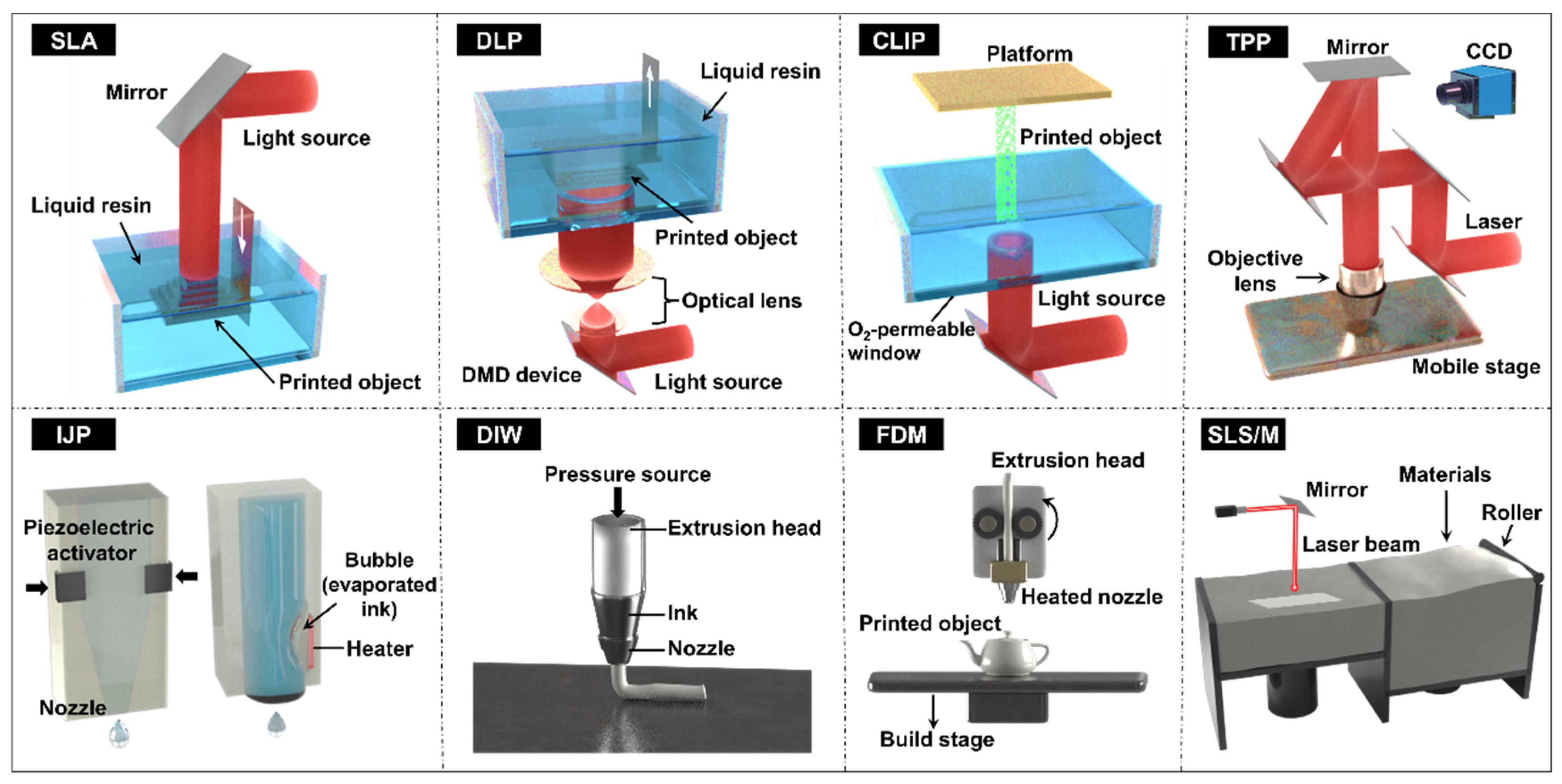


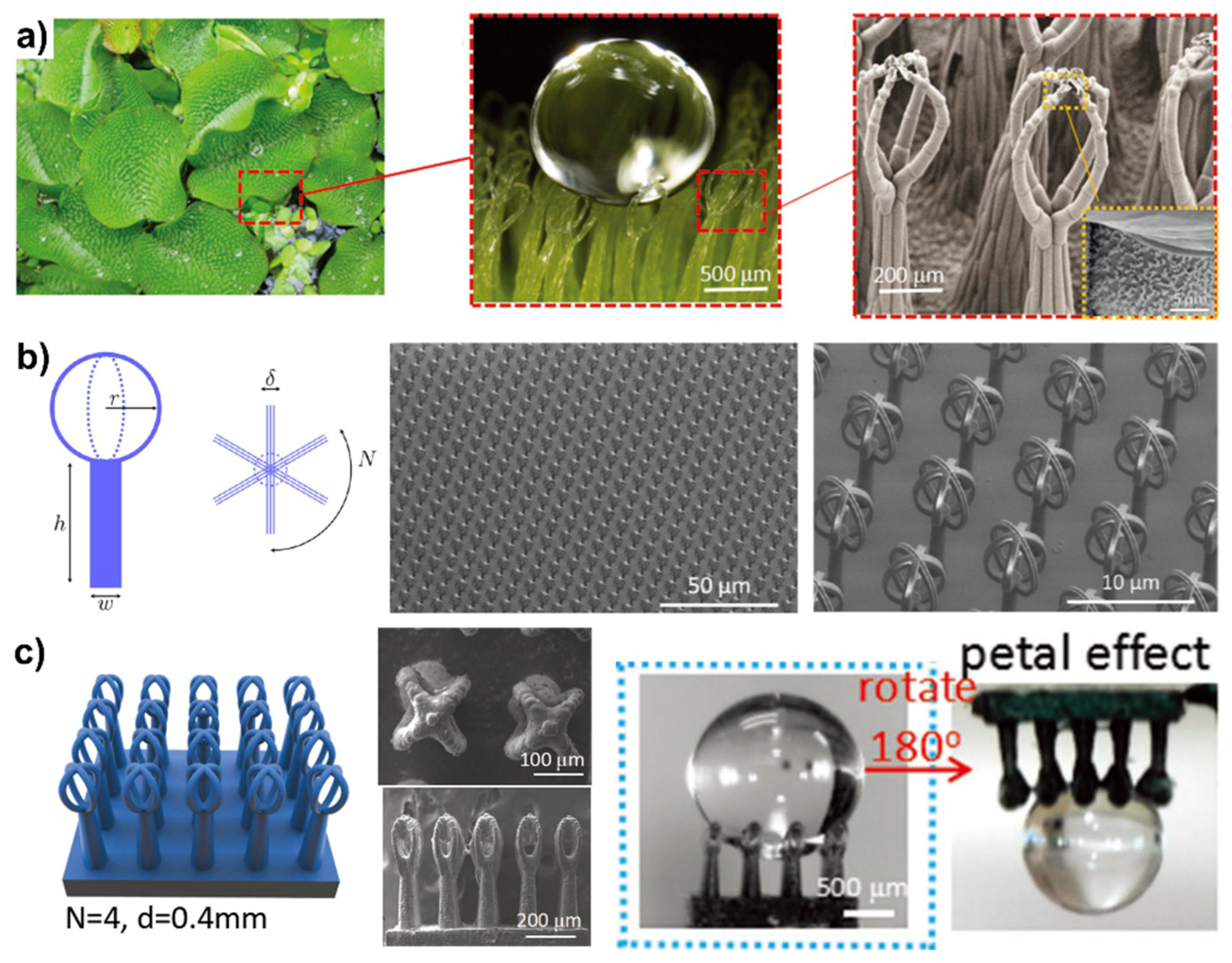
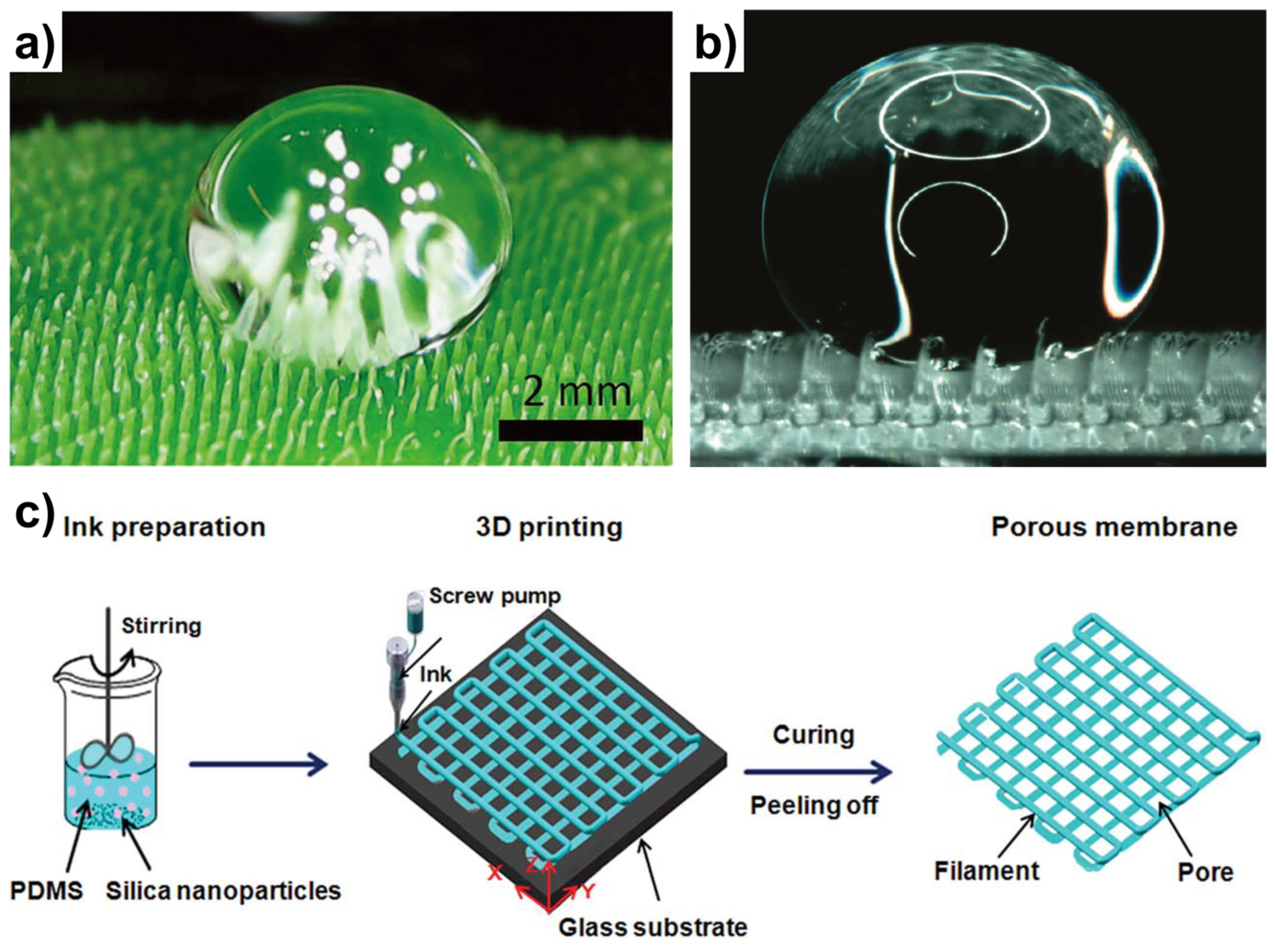
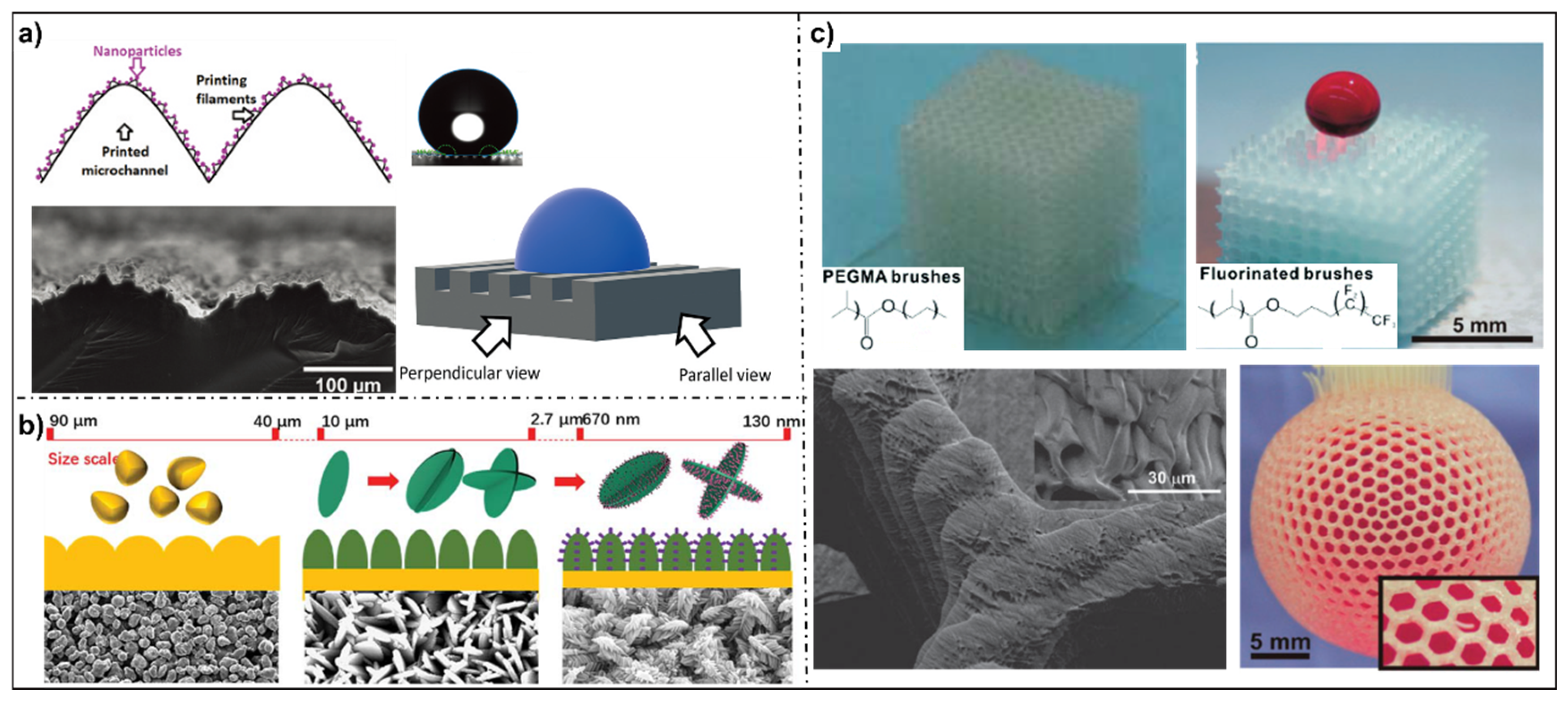
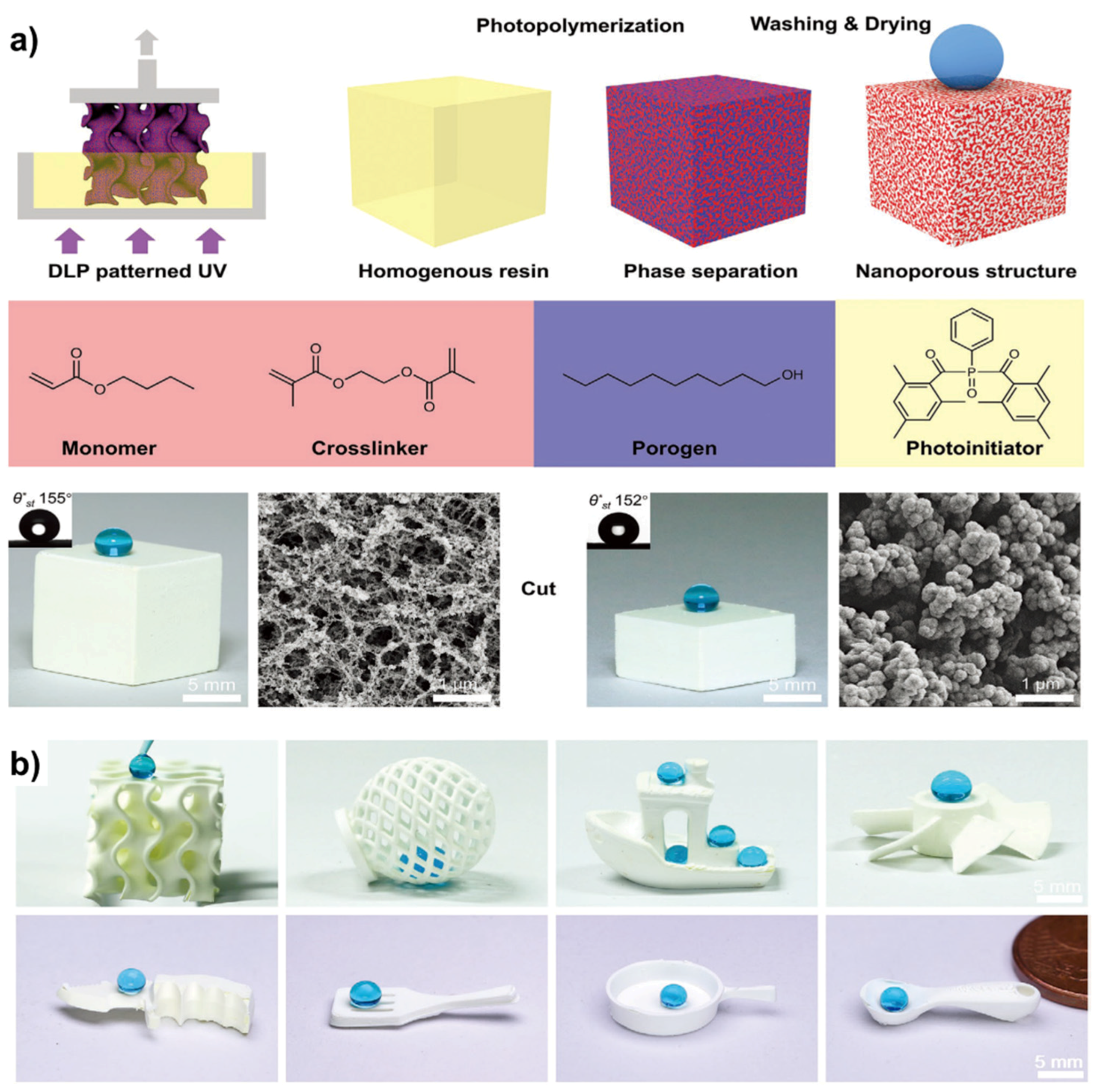

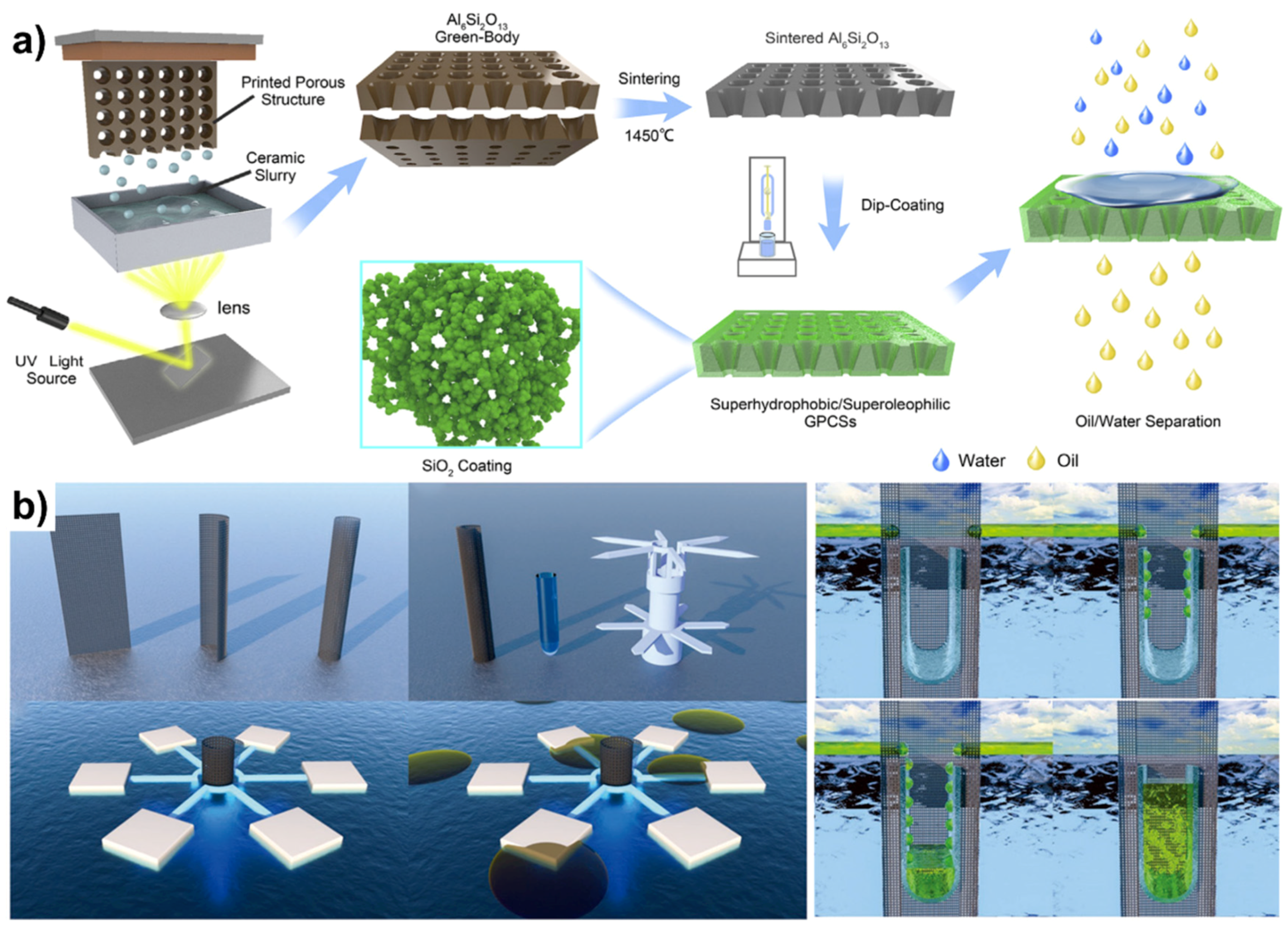
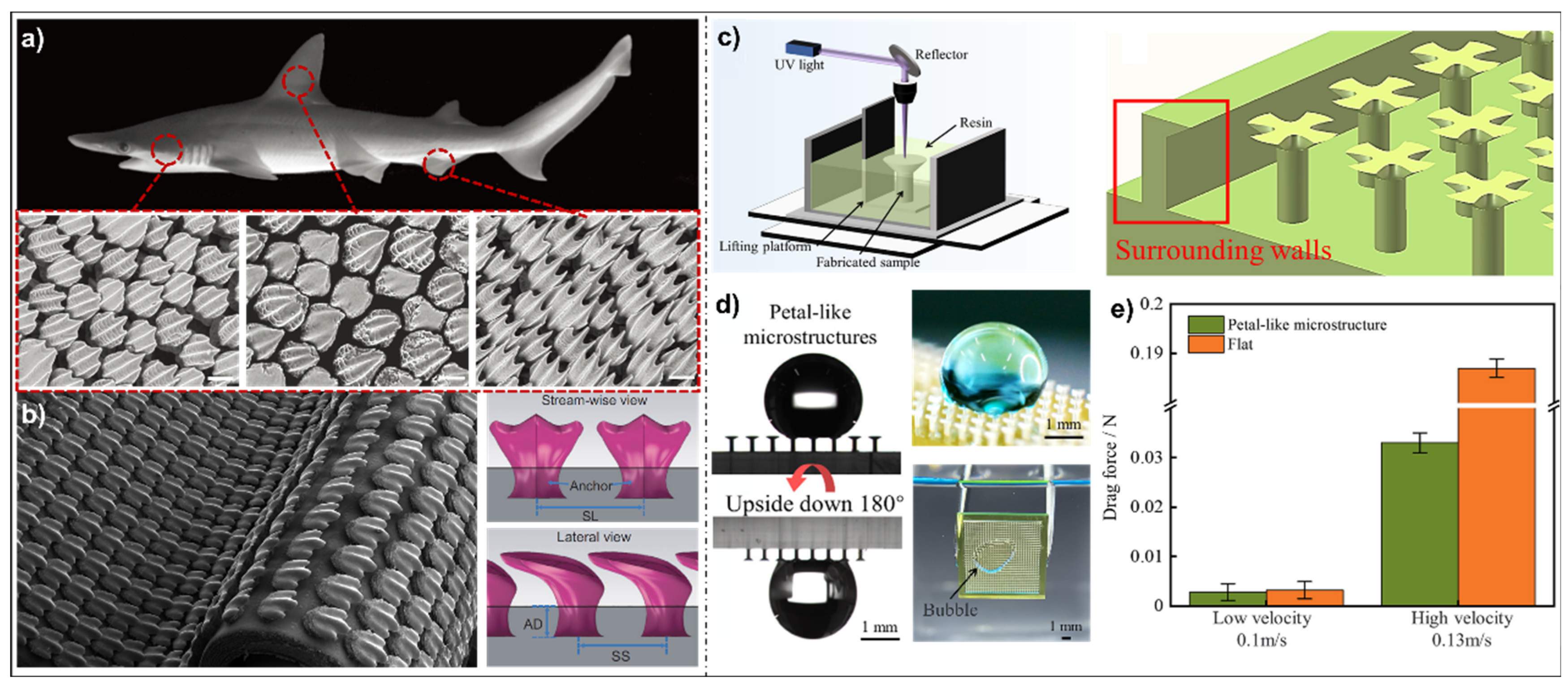

| Technique | Pros | Cons | Typical Materials | Printing Resolution |
|---|---|---|---|---|
| SLA |
|
| Photoresins | 100 nm |
| DLP |
|
| Photoresins | 100 nm |
| CLIP |
|
| Low-viscosity Photoresins | 75 μm |
| TPP |
|
| Transparent photoresins | <100 nm |
| IJP |
|
| Polymers, pigments, nanoparticles | 50 μm |
| DIW |
|
| Ceramics, metals, zeolites | 5 μm (1–100 μm) |
| FDM |
|
| Polymers, metals | 100 μm |
| SLS/M |
|
| Metals, ceramics, polymers | 50 μm |
Disclaimer/Publisher’s Note: The statements, opinions and data contained in all publications are solely those of the individual author(s) and contributor(s) and not of MDPI and/or the editor(s). MDPI and/or the editor(s) disclaim responsibility for any injury to people or property resulting from any ideas, methods, instructions or products referred to in the content. |
© 2023 by the authors. Licensee MDPI, Basel, Switzerland. This article is an open access article distributed under the terms and conditions of the Creative Commons Attribution (CC BY) license (https://creativecommons.org/licenses/by/4.0/).
Share and Cite
Liu, H.; Zhang, Z.; Wu, C.; Su, K.; Kan, X. Biomimetic Superhydrophobic Materials through 3D Printing: Progress and Challenges. Micromachines 2023, 14, 1216. https://doi.org/10.3390/mi14061216
Liu H, Zhang Z, Wu C, Su K, Kan X. Biomimetic Superhydrophobic Materials through 3D Printing: Progress and Challenges. Micromachines. 2023; 14(6):1216. https://doi.org/10.3390/mi14061216
Chicago/Turabian StyleLiu, Haishuo, Zipeng Zhang, Chenyu Wu, Kang Su, and Xiaonan Kan. 2023. "Biomimetic Superhydrophobic Materials through 3D Printing: Progress and Challenges" Micromachines 14, no. 6: 1216. https://doi.org/10.3390/mi14061216
APA StyleLiu, H., Zhang, Z., Wu, C., Su, K., & Kan, X. (2023). Biomimetic Superhydrophobic Materials through 3D Printing: Progress and Challenges. Micromachines, 14(6), 1216. https://doi.org/10.3390/mi14061216







